IKEA Mattress Reviews - A Complete Guide To Choosing The Best Ikea Mattress
If you’re in need of a wallet friendly mattress that comes with a stronger guarantee of quality then what you can normally get from a low-cost manufacturer, the IKEA mattress lineup is worth a look. The popular Sweden based housewares retailer has a diverse lineup of products, geared towards budget minded consumers, all backed by generous money back, exchange and return policies for your peace of mind.
However, you may be wondering about the flipside to this affordability – and you’d be right – these mattresses are not high-end. That’s why we’ve compiled these guide to popular IKEA mattress reviews, so that you can decide whether their offerings will meet your sleeping needs.
You may be interested in: Ultimate Mattress Buyers Guide – How To Choose A Mattress
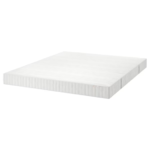
1. IKEA Matrand Mattress Lineup – Editor's Choice
- Affordably priced.
- Memory foam for those who want firm, pressure relieving comfort.
- Latex for those who prioritize heat dissipation and a slightly soft feel.
- Works well for both child and adult use.
- 25 Year Warranty
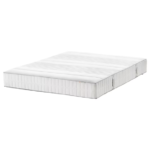
2. IKEA’s Myrbacka Mattress Lineup
- Reasonably priced. Memory foam can handle borderline overweight individuals.
- Considerably higher than average user satisfaction.
- 25 Year Warranty
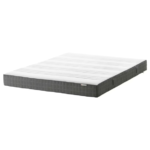
3. IKEA Morgedal Foam Mattress
- Inexpensive.
- Available in both firm and medium-firm varieties.
- High resilience layer enables it to last longer than other cheap foam options.
- 25 Year Warranty
Table Of Contents
- Our Review Process
- Top Rated IKEA Mattress Reviews
- 1. IKEA Matrand Mattress Review
- 2. IKEA Myrbacka Mattress Review
- 3. IKEA Morgedal Mattress Review
- IKEA: History and Vision
- Where are IKEA Mattresses made?
- An overview of IKEA mattresses
- Latex Lineup
- Innerspring Lineup
- Are IKEA Mattresses Good Then?
- Returns and Warranty
- Who Should Get IKEA Mattresses?
- Who Shouldn’t Get IKEA Mattresses?
- Conclusion
Top Rated IKEA Mattress Reviews
1. IKEA Matrand Mattress Review – Editor's Choice
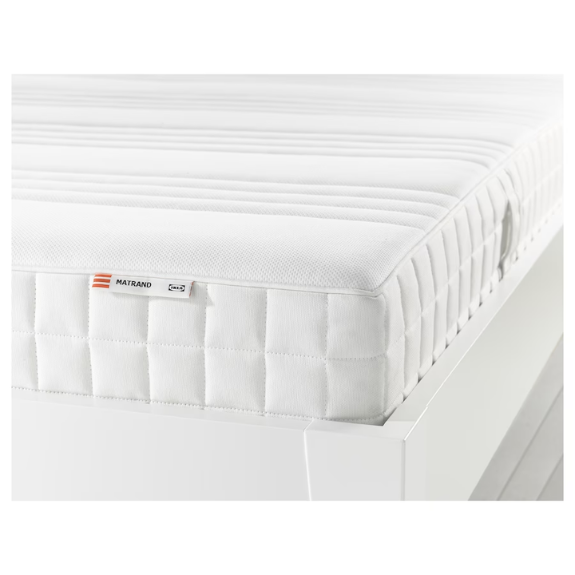
Highlights
- Material: Memory Foam and Latex
- Thickness: 7 1/8”
- Other Features: Cotton / poly cover; Polypropylene lining; Poly / rayon fiber
Pros
- Affordably priced.
- Memory foam for those who want firm, pressure relieving comfort.
- Latex for those who prioritize heat dissipation and a slightly soft feel.
- Works well for both child and adult use.
Cons
- Latex version only available in Queen size.
- Some issues with sagging and deformity.
The memory foam variant of the Matrand series is 7 1/8” thick, and incorporates 3.1 lb/cu.ft. polyurethane memory foam, as well as 1.7 lb/cu.ft. regular polyurethane foam. Supporting the memory foam with a layer of regular foam extends the lifetime of this budget product, and lends it a firm feel that the latex variant cannot achieve with its single 1.7 lb/cu.ft. polyurethane layer.
That said, the 7 1/7” thick latex version will appeal more to sleepers who are particular about heat dissipation and prefer a slightly soft feel on their mattress’s surface. Unfortunately, it is only available in Queen size. The memory foam version is available in Twin, Full, Queen and King sizes, and offers far more freedom of choice.
Purchasers have generally been very pleased with the comfort and support offered by these mattresses, and have especially commended its suitability for children. Naturally, given the low price, some complaints about sagging and deformation are to be expected.
This mid-tier sleep solution is available in both memory foam and latex core varieties, and accommodates budget buyers who want a little more luxury than what a regular foam mattress can offer.
2. IKEA Myrbacka Mattress Review
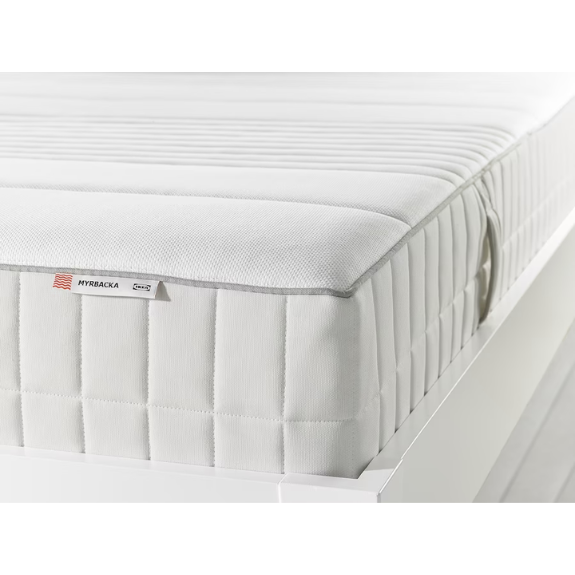
Highlights
- Material: Memory Foam and Latex
- Thickness: 9 ½”
- Other Features: Cotton / poly cover; Polypropylene lining; Wool and rayon / poly fiber
Pros
- Reasonably priced. Memory foam can handle borderline overweight individuals.
- Considerably higher than average user satisfaction.
Cons
- Latex version only comes in Queen size.
- Limited issues with impression formation / sagging.
The memory foam option, besides its 3.1 lb/cu.ft. memory foam layer, also has a 2.2 lb/cu.ft. high resilience polyurethane foam layer and a 1.7 lb/cu.ft. regular foam layer. Collectively, these layers are 9 ½” thick, and make for a remarkably durable and supportive product that can handle a BMI between 20 and 25, at a price that is still quite affordable for the average consumer.
The latex model employs a single 2.2 lb/cu.ft. high resilience foam layer, in addition to its synthetic latex core, which is better suited to individuals who need a medium-firm surface for optimal comfort i.e. those with a normal BMI under 25. Its thickness is also 9 ½”, so it will still last you a good while longer than other low-cost latex solutions.
Both latex and memory foam options have received higher than average praise from consumers, which is a mark of their resilience in spite of being far from premium solutions. The memory foam version is available in Full, Queen, and King sizes, whereas the latex option is available only in Queen size.
The Myrbacka series follows the same general principle as its cheaper sibling – Matrand – by letting you choose between memory foam and latex, but bolsters its service period somewhat through the incorporation of thicker layers of high resilience polyurethane foam, to provide a longer lasting sleeping solution.
3. IKEA Morgedal Mattress Review
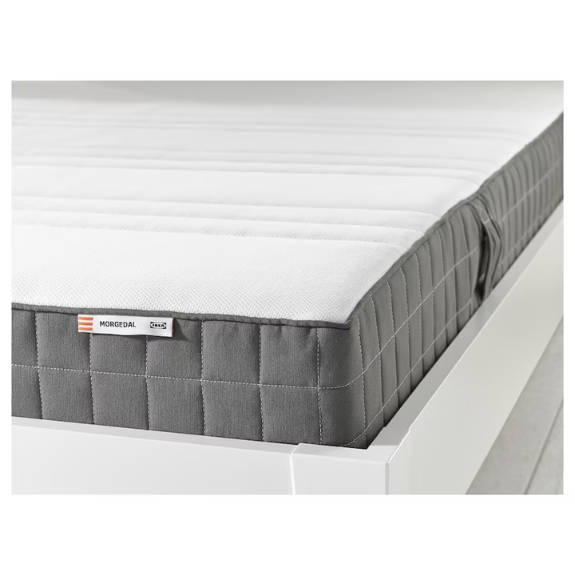
Highlights
- Material: Foam
- Thickness: 7 1/8”
- Other Features: Cotton / poly cover; Polypropylene lining; Poly / rayon fiber
Pros
- Inexpensive.
- Available in both firm and medium-firm varieties.
- High resilience layer enables it to last longer than other cheap foam options.
Cons
- Only available in Queen size.
It has a high resilience polyurethane foam layer with a 2.2 lb/cu.ft. density in its core, besides the expected 1.7 lb/cu.ft. regular foam layer. The high resilience layer enables this otherwise ordinary foam offering to withstand a good degree of punishment before it starts to sag, and is reflected in the positive feedback about its performance from consumers.
Other than that, the mattress has an overall thickness of 7 1/8”, with a cotton / polyester cover and polypropylene lining that are pretty much standard fare. One other thing I admire about this product is that it is available in both firm and medium-firm varieties to cater to a larger segment of sleepers.
It’s a shame that it is available exclusively in Queen size though, since this combination of thickness and resilience at such a low cost isn’t available in other IKEA offerings.
Moregdal is IKEA’s cheapest foam line, intended for those who want a reasonably comfortable queen-sized bedding solution that won’t break as quickly as most cheap foam mattresses..
IKEA: History and Vision

IKEA is a big-box retailer of household furnishings, founded by Ingvar Kamprad of Sweden in 1951. Today, they have several dozen outlets spread across the United States and also sell some of their merchandise online – mattresses included. From the beginning, IKEA’s focus has been the provision of an affordable range of home furnishing products to the masses, to improve their quality of life.
Where are IKEA Mattresses made?

Some of us judge the quality of a product based on its region of manufacture – and while the effectiveness of this criteria varies from product to product, for a mattress, this holds true: a mattress that is made in Asia, for example, will have to be shipped in a container, and if it is already made of cheaper materials, the compressed manner in which it was stored might affect its lifetime..
This is besides the fact that Chinese manufacturers often use sub-par practices to cut expenses. There’s good news as far as IKEA is concerned, for all their mattresses are made in North America, and several of them are roll packed for convenient transportation without damage.
An overview of IKEA mattresses
At present, IKEA sells 15 different mattress series (8 foam and latex, 7 spring), that range from cheap to slightly expensive. The quality of their mattresses, of course, varies with the price, but each of their products is backed by competitive exchange / return / warranty policies.
IKEA’s foam mattress lineup is significantly cheaper than the industry average – at around $90 to $600. This comes at the cost of reduced foam density, and use of regular foam as opposed to memory foam, and translates into reduced lifetime. Indeed, it is reflected in complaints about sagging.
See more IKEA foam mattress reviews here.
Latex Lineup
The following products are offered as part of this lineup:
The latex lineup is somewhat pricier – ranging from $400 to $1200, but still considerably lower than what is charged by premium manufacturers. The manufacturer achieves these low prices by employing cheaper Dunlop process latex as opposed to the more expensive Talalay latex.
Furthermore, most of these products use synthetic latex instead of the natural variety. Dunlop latex doesn’t mean poor durability, but it does lend the mattress a firmer, more durable (yet less consistent) feel than what you’d get with Talalay.
See more IKEA latex mattress reviews here.
Innerspring Lineup
The following products are offered as part of this lineup:
IKEA’s spring mattress lineup is again, quite inexpensive as compared to the market average, ranging from $80 to $1000. This is achieved by reducing the coil count on most of their spring mattresses (and using cheap Bonnell spring coils on their cheapest offerings), resulting in a greater likelihood of issues such as sag and deformation that may cause back ache, particularly for weighty individuals.
Are IKEA Mattresses Good Then?
Even if you’ve been a bit put off by the mention of complaints about durability, keep in mind that these aren’t premium quality mattresses. That said, they’ll offer a respectable degree of comfort for the average sleeper, provided they aren’t overweight. Combine this with their excellent returns policy, and you’ve got a product that provides remarkable bang for the (limited) investment it requires.
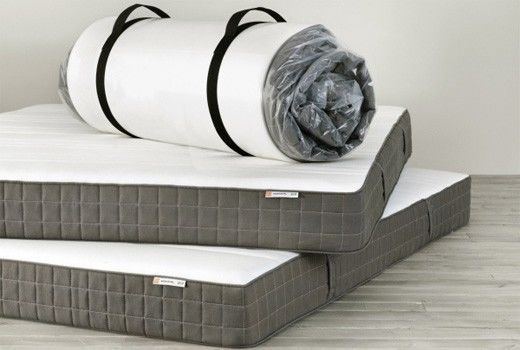
Returns and Warranty
A full refund is available on all IKEA products within 365 days of purchase. For mattresses, IKEA also offers a 365 day exchange policy that you can avail if you are dissatisfied with your purchase. However, they do require a photo ID, and that the mattress not be damaged, abused, stained or dirty. We suggest getting a mattress protector.
IKEA also offers a 25 year limited warranty on all mattresses, much higher than what is usual for cheap offerings. Defects in springs, foam cores and latex cores are covered under this warranty. Note that normal wear and tear is not covered.
Who Should Get IKEA Mattresses?
Students: When the time came for me to leave my parents’ house and move to my dorm in college, I had to compromise on a second hand mattress to keep all the rest of the furniture in my budget. Now, with consumerism at its peak, brand new mattress options – such as IKEA’s ultra-cheap Jomna series – are available to budding college students.
These are at the bottom rung as far as durability goes – but hey, you won’t be staying in college forever!
People who are constantly changing houses: People who are constantly shifting e.g. a young working couple living in a metropolis, pursuing better apartment rents, have to face the challenge of moving their bulky and delicate belongings.
An expensive mattress falls under this category, and given its size, unless you hire paid help, there’s a good chance you’ll end up damaging it each time you move. The same risk exists with cheaper options, but ultimately, it’s much easier to overlook a few nicks on a cheap mattress than it is one a top-of-the-line mattress that you got from hard earned (and saved) cash.
Children: Owing to their lower body weight, children’s bodies (generally) are less taxing on low density bedding. This means that there’s a good chance the same mattress from IKEA will last your child throughout their childhood years i.e. 7 to 15 years, until their needs begin to alter.
Who Shouldn’t Get IKEA Mattresses?
Adults with a BMI value higher than 25 are advised not to go for low density, low thickness mattresses (making up much of IKEA’s offering) unless they are expressly seeking a low-cost, temp solution that won’t last more than a couple years. There are plenty of other options out there which will last you far longer, albeit at a higher cost.
If you’re still convinced to buy from IKEA, I’d recommend spending some extra cash on the memory foam and natural latex options if you want the best in terms of comfort (and a little more life) out of your purchase.
You may want to check: Best IKEA Down Alternative Comforters
Conclusion
Having reached the end of this guide, you’ll hopefully have discovered a manufacturer that caters to the mainstream consumer market that can’t afford ultra-expensive sleeping solutions. The most likeable thing about IKEA (besides their extensive returns policy) is that (for the most part) they don’t make flashy claims about their mattresses’ capabilities, and accurately detail the components and features of their products.
This allows consumers to easily make comparisons and decide which product suits their needs, and spares them from making a costly mistake. The best IKEA mattresses may be some of the most expensive IKEA mattresses out there, but the value they pack in validates the price. Just like every other mattress company, you get what you pay for with IKEA.
